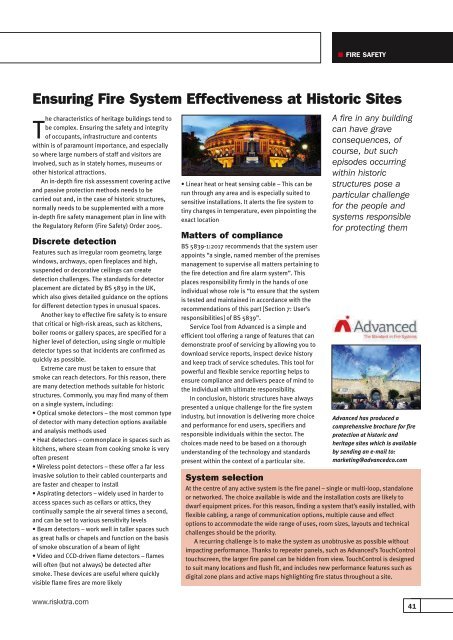RiskXtraSeptember2018
You also want an ePaper? Increase the reach of your titles
YUMPU automatically turns print PDFs into web optimized ePapers that Google loves.
FIRE SAFETY<br />
Ensuring Fire System Effectiveness at Historic Sites<br />
The characteristics of heritage buildings tend to<br />
be complex. Ensuring the safety and integrity<br />
of occupants, infrastructure and contents<br />
within is of paramount importance, and especially<br />
so where large numbers of staff and visitors are<br />
involved, such as in stately homes, museums or<br />
other historical attractions.<br />
An in-depth fire risk assessment covering active<br />
and passive protection methods needs to be<br />
carried out and, in the case of historic structures,<br />
normally needs to be supplemented with a more<br />
in-depth fire safety management plan in line with<br />
the Regulatory Reform (Fire Safety) Order 2005.<br />
Discrete detection<br />
Features such as irregular room geometry, large<br />
windows, archways, open fireplaces and high,<br />
suspended or decorative ceilings can create<br />
detection challenges. The standards for detector<br />
placement are dictated by BS 5839 in the UK,<br />
which also gives detailed guidance on the options<br />
for different detection types in unusual spaces.<br />
Another key to effective fire safety is to ensure<br />
that critical or high-risk areas, such as kitchens,<br />
boiler rooms or gallery spaces, are specified for a<br />
higher level of detection, using single or multiple<br />
detector types so that incidents are confirmed as<br />
quickly as possible.<br />
Extreme care must be taken to ensure that<br />
smoke can reach detectors. For this reason, there<br />
are many detection methods suitable for historic<br />
structures. Commonly, you may find many of them<br />
on a single system, including:<br />
• Optical smoke detectors – the most common type<br />
of detector with many detection options available<br />
and analysis methods used<br />
• Heat detectors – commonplace in spaces such as<br />
kitchens, where steam from cooking smoke is very<br />
often present<br />
• Wireless point detectors – these offer a far less<br />
invasive solution to their cabled counterparts and<br />
are faster and cheaper to install<br />
• Aspirating detectors – widely used in harder to<br />
access spaces such as cellars or attics, they<br />
continually sample the air several times a second,<br />
and can be set to various sensitivity levels<br />
• Beam detectors – work well in taller spaces such<br />
as great halls or chapels and function on the basis<br />
of smoke obscuration of a beam of light<br />
• Video and CCD-driven flame detectors – flames<br />
will often (but not always) be detected after<br />
smoke. These devices are useful where quickly<br />
visible flame fires are more likely<br />
• Linear heat or heat sensing cable – This can be<br />
run through any area and is especially suited to<br />
sensitive installations. It alerts the fire system to<br />
tiny changes in temperature, even pinpointing the<br />
exact location<br />
Matters of compliance<br />
BS 5839-1:2017 recommends that the system user<br />
appoints “a single, named member of the premises<br />
management to supervise all matters pertaining to<br />
the fire detection and fire alarm system”. This<br />
places responsibility firmly in the hands of one<br />
individual whose role is “to ensure that the system<br />
is tested and maintained in accordance with the<br />
recommendations of this part [Section 7: User’s<br />
responsibilities] of BS 5839”.<br />
Service Tool from Advanced is a simple and<br />
efficient tool offering a range of features that can<br />
demonstrate proof of servicing by allowing you to<br />
download service reports, inspect device history<br />
and keep track of service schedules. This tool for<br />
powerful and flexible service reporting helps to<br />
ensure compliance and delivers peace of mind to<br />
the individual with ultimate responsibility.<br />
In conclusion, historic structures have always<br />
presented a unique challenge for the fire system<br />
industry, but innovation is delivering more choice<br />
and performance for end users, specifiers and<br />
responsible individuals within the sector. The<br />
choices made need to be based on a thorough<br />
understanding of the technology and standards<br />
present within the context of a particular site.<br />
System selection<br />
A fire in any building<br />
can have grave<br />
consequences, of<br />
course, but such<br />
episodes occurring<br />
within historic<br />
structures pose a<br />
particular challenge<br />
for the people and<br />
systems responsible<br />
for protecting them<br />
Advanced has produced a<br />
comprehensive brochure for fire<br />
protection at historic and<br />
heritage sites which is available<br />
by sending an e-mail to:<br />
marketing@advancedco.com<br />
At the centre of any active system is the fire panel – single or multi-loop, standalone<br />
or networked. The choice available is wide and the installation costs are likely to<br />
dwarf equipment prices. For this reason, finding a system that’s easily installed, with<br />
flexible cabling, a range of communication options, multiple cause and effect<br />
options to accommodate the wide range of uses, room sizes, layouts and technical<br />
challenges should be the priority.<br />
A recurring challenge is to make the system as unobtrusive as possible without<br />
impacting performance. Thanks to repeater panels, such as Advanced’s TouchControl<br />
touchscreen, the larger fire panel can be hidden from view. TouchControl is designed<br />
to suit many locations and flush fit, and includes new performance features such as<br />
digital zone plans and active maps highlighting fire status throughout a site.<br />
www.riskxtra.com<br />
41

















